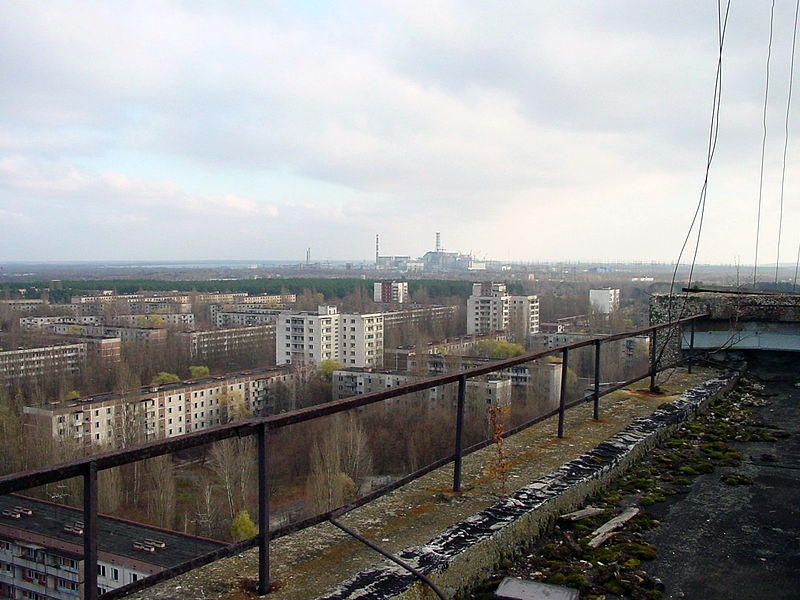Chernobyl 1) 2) 3) 4) 5) 6)
The disaster began during a systems test on Saturday, 26 April 1986 at reactor number four of the Chernobyl plant, which is near the city of Prypiat and in proximity to the administrative border with Belarus and the Dnieper River. There was a sudden and unexpected power surge, and when an emergency shutdown was attempted, an exponentially increasing spike in power output occurred, which led to a reactor vessel rupture and a series of steam explosions. These events exposed the graphite moderator of the reactor to air, causing it to ignite. The resulting fire sent a plume of highly radioactive fallout into the atmosphere. The plume drifted over large parts of the western Soviet Union and Europe. From 1986 to 2000, 350,400 people were evacuated and resettled from the most severely contaminated areas of Belarus, Russia, and Ukraine.
Estimates of the number of deaths that will eventually result from the accident vary enormously; the disparities in these estimates reflect both the lack of solid scientific data and the different methodologies used to quantify mortality ? whether the discussion is confined to specific geographical areas or extends worldwide, and whether the deaths are immediate, short term, or long term.
Thirty deaths (including 28 deaths that were due to radiation exposure) are directly attributed to the accident, all among the reactor staff and emergency workers. An UNSCEAR report places the total confirmed deaths from radiation at 64 as of 2008. Average exposure doses for residents living around the Chernobyl nuclear accident site were assessed in a 2008 UNSCEAR report to have been 33 mSv for 116,000 evacuees, more than 50 mSv for 270,000 residents of areas with the highest contamination levels, and 10-20 mSv for 5.0 million residents of areas with low contamination levels. Observing such residents of these surrounding areas, there are some physicians and other healthcare workers who have pointed out increases in various other types of disease. However, the consensus understanding among such international organizations as UNSCEAR, WHO and the IAEA is that no increases in leukemia or other illnesses have been scientifically confirmed among the general population including children.


View of Chernobyl Reactor 4 after the Accident 7)
References
1) United Nations Scientific Committee on the Effects of Atomic Radiation , UNSCEAR 2008 Report to the General Assembly, with scientific annexes: Scientific Annex D
2) The Chernobyl Forum: 2003?2005, Chernobyl’s Legacy: Health, Environmental and Socio-Economic Impacts and Recommendations to the Governments of Belarus, the Russian Federation and Ukraine
3) Kholosha, V.I., N.G. Koval’skij and A.A. Babich. Social, economic, institutional and political impacts. Report for Ukraine. p. 429-444 in: One Decade After Chernobyl. Summing up the Consequences of the Accident. Proceedings of an International Conference, Vienna, 1996. STI/PUB/1001. IAEA, Vienna, 1996.
4) Rolevich, I.V., I.A. Kenik, E.M. Babosov et al. Social, economic, institutional and political impacts. Report for Belarus. p. 411-428 in: One Decade After Chernobyl. Summing up the Consequences of the Accident. Proceedings of an International Conference, Vienna, 1996. STI/PUB/1001. IAEA, Vienna, 1996.
5) Voznyak, V.Ya. Social, economic, institutional and political impacts. Report for the Soviet period. p. 369-378 in: One Decade After Chernobyl. Summing up the Consequences of the Accident. Proceedings of an International Conference, Vienna, 1996. STI/PUB/1001. IAEA, Vienna, 1996.
6) Voznyak, V.Ya. Social, economic, institutional and political impacts. Report for the Russian Federation. p.379-410 in:One Decade After Chernobyl. Summing up the Consequences of the Accident. Proceedings of an International Conference, Vienna, 1996. STI/PUB/1001. IAEA, Vienna, 1996.
7) International Atomic Energy Agency, Environmental consequences of the Chernobyl accident and their remediation : twenty years of experience / report of the Chernobyl Forum Expert Group 'Environment', IAEA, Vienna (2006).
(http://www-pub.iaea.org/mtcd/publications/pdf/pub1239_web.pdf#page=155)